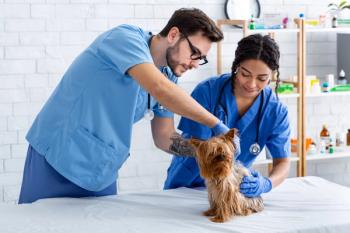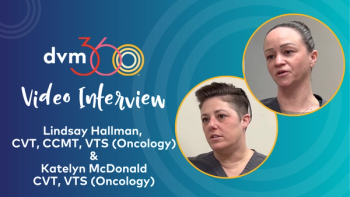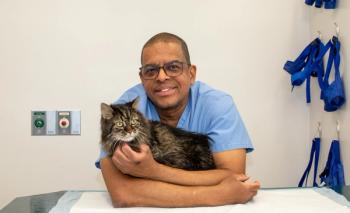
Care and maintenance of endoscopy equipment (Proceedings)
Your clinic's flexible endoscopes and its instrumentation can be a major purchase for your clinic.
Your clinic's flexible endoscopes and its instrumentation can be a major purchase for your clinic. Damage to your endoscope can lead to costly repairs, so it's important to become familiar with proper care and handling techniques. We hope that these guidelines will help your endoscope function efficiently for years to come.
Cleaning your endoscope
It's important to establish an effective manual cleaning protocol prior to high-level disinfection. A significant amount of foreign material and organisms are removed from the endoscope at this stage. Manual cleaning should begin as soon as the scope is removed from the patient. Have a bowl of enzymatic cleaning solution (mixed with water according to manufacturers instructions) available.
Note: Always read the manufacturers manual first. Some older endoscopes cannot be totally immersed in water. If your endoscope did not include a manual, call the manufacturer for a copy.
When the procedure is completed
1. Depress air/water valve to force water through the water channel.
2. Place finger over the air/water valve to force air through the air channel.
3. Depress suction valve with distal tip in cleaning solution, then remove distal tip from solution and suction air. Alternating air and cleaning solution will remove more debris from internal lumens.
4. Endoscopes with air/water cleaning adapters: This adapter allows continuous air or water through both the air and water channels (not to be confused with an all-channel irrigator that could flood your light source). Turn off air pump, remove air/water valve and attach cleaning adapter. Turn air pump on and allow air through channels for 30-45 seconds. Depress valve to allow water to run through channels.
5. Turn off power to the light source, video processor or camera, and then detach the endoscope. If indicated, place protective cap over video connective ports.
6. Wipe excess debris off endoscope with gauze sponges and enzymatic cleaning solution. Carefully transport your endoscope and accessories to a cleaning station for thorough cleaning and disinfection.
Cleaning the endoscope in the reprocessing area
Have gauze sponges, enzymatic cleaning solution, leak tester and appropriate sized channel cleaning brushes available. Protective eyewear or face shields with exam gloves are also recommended.
1. Leak testing–attach the leak tester and pressurize endoscope. Submerge all but the terminal end (where leak tester is attached). Angulate distal tip and observe for bubbles, which would indicate a leak has occurred. IF THE ENDOSCOPE DOES NOT LEAK TEST, DO NOT PROCEED AND CONTACT MANUFACTURER. At the end of 2 minutes, remove air by leaving the leak tester attached for 30 seconds.
2. Brush suction/biopsy channel–there are 3 areas of this channel that are brushed in GI scopes:
- Biopsy channel–from biopsy port opening to distal tip.
- Umbilical tube–from suction valve housing to suction port at terminal end (some endoscopes require starting at suction port, then out at the suction valve housing).
- Suction valve opening to distal tip–At the suction valve housing, angle brush to enter channel, which exits at the distal tip. Note: Some models of endoscopes will only allow brushing from the valve housing to the biopsy port opening. If resistance is felt, do not advance the brush through the insertion tube to the distal tip.
After each passage, wipe off brushes. Periodically inspect your brushes and replace when frayed, bent or damaged.
3. Clean the outside of your endoscope with gauze and enzymatic cleaning solution.
4. Attach irrigation adapters. Each manufacturer requires different adapters for their different models of endoscopes. It's important to attach all adapters for irrigation of the endoscope and that cleaning solution (and high level disinfection solution) will achieve adequate flow through all lumens. Solution will exit air, water and suction ports on the terminal end, as well as the suction/biopsy, air and water nozzles at the distal tip. Special attention should be given to the water nozzle, since this is the only area that cannot be brushed. A continuous stream of cleaning solution should be observed. If a partial or intermittent stream is observed, let cleaning solution sit in the channel. Never proceed beyond this step if there is a blockage to any parts of the channel!!!!!!!.
5. Clean endoscope accessories. Valves should be inspected and cleaned. Rubber o-rings on valves should not be torn or missing. Valves should also be depressed to expose hidden ports and rubber o-rings. Pipe cleaner and toothbrushes work well to clean valves and other accessories.
Biopsy forceps are wire wrapped and should be ultrasonically cleaned, then sterilized. Don't forget biopsy port cover and mouth gags.
6. Rinse endoscope. Flush all ports well with clean water.
7. Dry endoscope. Force air through all ports, then dry exterior with a soft cloth. Removing as much water as possible will prevent dilution of disinfectant.
High level disinfection
Choose a glutaraldehyde solution that does not contain a surfactant, preferably a 2.6% alkaline product. When activated, glutaraldehyde solutions will have a 2 week shelf life.
1. Carefully coil endoscope into immersion tub filled with glutaraldehyde.
2. With irrigation adapters attached, inject glutaraldehyde through all ports, making sure that the disinfectant is exiting all ports.
3. Contact with a high-level disinfectant should be according to the manufacturer's instructions. However, with an effective manual cleaning protocol, 20 minutes in a 2.6% glutaraldehyde solution at room temperature should be sufficient for complete microbial destruction.
4. Endoscope accessories should also be disinfected. Be careful with sharp instruments such as dental probes which could puncture the endoscope.
5. At the completion of the cycle, flush endoscope and outer surfaces with copious amounts of water.
Drying
1. Flush endoscope with 70% isopropyl alcohol. The alcohol mixes with the remaining water on channel surfaces and encourages evaporation.
2. If forced air is available, attach to irrigation adapters for 20-30 minutes and hang endoscope.
3. Remove irrigation adapters. Make sure exterior of the endoscope is dry.
4. Dry and hang biopsy forceps with jaws open. Dry all other endoscope accessories.
5. Apply a small amount of silicone oil to O-rings on valves.
6. Your endoscope should be stored in a hanging position, and never in the storage case. In a flat, coiled position, water could pool in the channel--an ideal site for bacterial growth. Choose a well-ventilated area in your hospital, away from excessive traffic.
Endoscope handling
Left hand holds the control section with the right hand controlling the insertion tip. Be aware of kinking of the upper end of the umbilical cord. Also, watch your distance from the table with the extra length of the insertion tube-too much "bend" could damage internal channels. When extracting endoscope from the oral cavity, keep your hand on the insertion tip and away from sharp teeth and endoscope banging on table end. Avoid twisting the insertion tip only, referred to as "torqueing" –when maneuvering, move the whole endoscope as one unit.
Positioning
Give yourself every advantage! Correct positioning for each procedure results in the safest maneuvering and the most information learned, which in turn shortens the patient's anesthesia time and achieves the most accurate diagnosis.
Left lateral recumbency—Gastroduodenoscopy & Colonoscopy
Right lateral recumbency—Proctoscopy, PEG tube placement, & Cystoscopy
Sternal recumbency—Proctoscopy, Bronchoscopy, Cystoscopy
Newsletter
From exam room tips to practice management insights, get trusted veterinary news delivered straight to your inbox—subscribe to dvm360.






